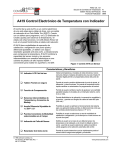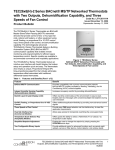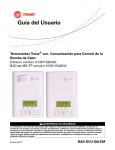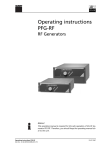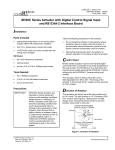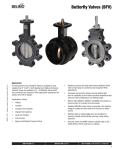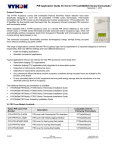Download Johnson Controls M9220-GGX-3 Automobile Parts User Manual
Transcript
M9220-GGx-3 Proportional Electric Spring Return Actuators Part No. 34-636-1697, Rev. B Installation Instructions Issued February 4, 2009 Supersedes June 20, 2006 Applications Installation The M9220-GGx-3 Proportional Electric Actuators are direct-mount, spring return electric actuators that operate on AC/DC 24V power. These bidirectional actuators do not require a damper linkage, and are easily installed on dampers with 1/2 to 3/4 in. or 12 to 19 mm round shafts, or 3/8 and 1/2 in. or 10, 12, and 14 mm square shafts using the standard shaft clamp included with the actuator. An optional M9220-600 Jackshaft Coupler Kit is available for 3/4 to 1-1/16 in. or 19 to 27 mm round shafts, or 5/8 and 3/4 in. or 16, 18, and 19 mm square shafts. The M9220-GGx-3 Proportional Electric Spring Return Actuators mount directly to the surface in any convenient orientation using two M3 x 9.5 mm self-drilling sheet metal screws and the anti-rotation bracket (parts included with the actuator). No additional linkages or couplers are required. Electrical connections are color-coded and identified with numbers permanently marked on the actuator cable. A tag on the actuator cable identifies the electrical connections, and wiring details are also included on the actuator housing. A single M9220-GGx-3 Series Proportional Electric Spring Return Actuator provides a running and spring return torque of 177 lb·in (20 N·m). Two or three like models mounted in tandem deliver twice or triple the torque (354 lb·in [40 N·m] or 531 lb·in [60 N·m]). Integral line voltage auxiliary switches are available on the GGC models to indicate end-stop position or to perform switching functions within the selected rotation range. IMPORTANT: Do not install or use this M9220 GGx-3 Proportional Electric Spring Return Actuator in or near environments where corrosive substances or vapors could be present. Exposure of the electric actuator to corrosive environments may damage the internal components of the device, and will void the warranty. IMPORTANT: Use this M9220-GGx-3 Proportional Electric Spring Return Actuator only to control equipment under normal operating conditions. Where failure or malfunction of the electric actuator could lead to personal injury or property damage to the controlled equipment or other property, additional precautions must be designed into the control system. Incorporate and maintain other devices such as supervisory or alarm systems or safety or limit controls intended to warn of, or protect against, failure or malfunction of the electric actuator. Parts Included • proportional electric spring return actuator with coupler • anti-rotation bracket • manual override crank • two M3 x 9.5 mm self-drilling sheet metal mounting screws • two No. 10-32 x 9/16 in. thread-forming conduit screws Special Tools Needed • torque wrench with 3/8 in. (10 mm) socket • digital voltmeter or M9000-200 Commissioning Tool • flat blade screwdriver M9220-GGx-3 Proportional Electric Spring Return Actuators Installation Instructions 1 Dimensions 4 (102) 2 (51) 1-19/32 (40) 1-19/32 (40) 3-3/16 (81) 1/8 (3) 3/4 (19) A 2-3/16 (56) 1-19/32 (40) 1-1/16 (27) 10-5/16 (262) 10 (254) 6-15/16 (176) 1/4 (6.5) Mounting Hole (6 Locations) 1 (25) 2-3/16 (56) FIG:M9210_9220_dimen 1-3/4 (44) Figure 1: M9220-GGx-3 Proportional Electric Spring Return Actuator Dimensions, in. (mm) 2 M9220-GGx-3 Proportional Electric Spring Return Actuators Installation Instructions Accessories Table 1: Accessories and Replacement Parts (Order Separately) Code Number Description DMPR-KC0031 7 in. (178 mm) Blade Pin Extension (without Bracket) for Johnson Controls Direct-Mount Damper Applications M9000-200 Commissioning Tool that Provides a Control Signal to Drive 24 V On/Off, Floating, Proportional, and/or Resistive Electric Actuators M9000-153 Crank arm M9000-158 Tandem Mounting Kit used to Mount Two Models of M9210/20 Proportional Electric Spring Return Actuators M9000-170 Remote Mounting Kit, Horizontal. Kit includes Mounting Bracket, M9000-153 Crank Arm, Ball Joint, and Mounting Bolts M9000-171 Remote Mounting Kit, Vertical. Kit includes Mounting Bracket, M9000-153 Crank Arm, Ball Joint, and Mounting Bolts M9000-320 Weather Shield Enclosure - NEMA 3R enclosure for protecting a single M9210/20 from rain, sleet, or snow. M9000-604 Replacement Anti-rotation Bracket Kit (with Screws) for M9210-xxx-3 Series Proportional Electric Spring Return Actuators M9220-600 1 in. (25 mm) Jackshaft Coupler Kit (with Locking Clip) for Mounting M9210-xxx-3 Series Proportional Electric Spring Return Actuators on Dampers with 3/4 to 1-1/16 in. or 19 to 27 mm Round Shafts, or 5/8 and 3/4 in. or 16, 18, and 19 mm Square Shafts M9220-601 Replacement Coupler Kit (with Locking Clip) for Mounting M9210-xxx-3 Series Proportional Electric Spring Return Actuators on Dampers with 1/2 to 3/4 in. or 12 to 19 mm Round Shafts, or 3/8 and 1/ 2 in. or 10, 12, and 14 mm Square Shafts M9220-602 Replacement Locking Clips for M9210-xxx-3 Series Proportional Electric Spring Return Actuators (Five per Bag) M9220-603 Adjustable Stop Kit for M9210-xxx-3 Series Proportional Electric Spring Return Actuators M9220-604 Replacement Manual Override Cranks for M9210-xxx-3 Series Proportional Electric Spring Return Actuators (Five per Bag) M9220-610 Replacement Shaft Gripper, 10 mm Square Shaft with Locking Clip M9220-612 Replacement Shaft Gripper, 12 mm Square Shaft with Locking Clip M9220-614 Replacement Shaft Gripper, 14 mm Square Shaft with Locking Clip 1. Furnished with the damper and may be ordered separately. Mounting The M9220-GGx-3 Proportional Electric Spring Return Actuators can be easily installed on dampers with 1/ 2 to 3/4 in. or 12 to 19 mm round shafts, or 3/8 and 1/ 2 in. or 10, 12, and 14 mm square shafts. An M9220600 Jackshaft Coupler Kit is available for 3/4 to 11/ 16 in. or 19 to 27 mm round shafts, or 5/8 and 3/4 in. or 16, 18, and 19 mm square shafts; see Table 1 for more details. If the damper shaft extends less than 3-19/32 in. (91 mm), see the Removable Coupler section for further instructions. If the damper shaft extends less than 1-5/32 in. (29 mm), install an extension recommended by the damper manufacturer. M9220-GGx-3 Proportional Electric Spring Return Actuators Installation Instructions 3 Counterclockwise (CCW) Spring Return Direction – Clockwise (CW) Powered Operation For CCW spring return direction, mount the actuator to the damper shaft so that Side A of the actuator is away from the damper as illustrated in Figure 2. With power applied, the actuator drives CW from the 0° position, and spring returns CCW. Removable Coupler The coupler may be installed on either side of the output hub. If the damper shaft is less than 3-19/32 in. (91 mm) long, insert the coupler in the face of the actuator closest to the damper. If the damper shaft is shorter than 1-5/32 in. (29 mm) long, a shaft extension is required to mount the actuator. U-Bolt Nut and Washer (Qty Two) Side A: CCW Spring Return Direction A Shaft Coupler Auxiliary Switch Adjuster Located on the Right 80 90 Pointer Showing Actuator in the Spring Return Position 10 70 60 50 40 30 20 Pointer -5 U-Bolt Locking Clip Assembled View of Coupler Subassembly FIG:sidea FIG:chpos Manual Override Figure 4: Changing the Position of the Coupler Figure 2: Side A of Actuator Clockwise (CW) Spring Return Direction – Counterclockwise (CCW) Powered Operation To change the spring return direction to CW, mount the actuator to the damper shaft so that Side B of the actuator is away from the damper as illustrated in Figure 3. With power applied, the actuator now drives CCW from the 0° position, and spring returns CW. Side B: CW Spring Return Direction B Auxiliary Switch Adjuster Located on the Left Pointer Showing Actuator in the Spring Return Position 10 -5 30 40 50 60 70 1. Mount the coupler on either Side A or Side B of the actuator, as determined by the shaft length. 2. Snap the locking clip securely into the coupler retention groove to retain the coupler. Manual Override Use only the supplied manual override crank to reposition the actuator hub when using the manual override feature. IMPORTANT: Applying excessive torque to the manual override or running the manual override with a power tool may damage the internal components of the actuator and cause premature failure. 80 20 To change the position of the coupler, see Figure 4 and proceed as follows: 90 To reposition the actuator hub, proceed as follows: 1. De-energize the actuator. 2. Insert the hex end of the manual override crank into the manual override adjustment point on the face of the actuator. FIG:sideb Manual Override 3. Rotate the manual override crank in the direction indicated by the arrow on the label. Figure 3: Side B of Actuator 4 M9220-GGx-3 Proportional Electric Spring Return Actuators Installation Instructions Note: The actuator requires 27 rotations of the manual override crank from the fully spring return position to fully reposition the actuator hub. At the end of travel, the rotational resistance increases; do not force the actuator hub past this point. 2. Bend or cut the anti-rotation bracket to fit the damper frame or duct as illustrated in Figure 6. Note: You can bend the anti-rotation bracket to fit a round damper. Anti-rotation Bracket 4. Rotate the manual override crank a half turn in the opposite direction to lock the actuator hub in place. Note: To unlock the actuator hub, rotate the manual override crank in the direction indicated by the arrow on the label. The actuator hub automatically unlocks when power is applied to the actuator, and returns the actuator to normal drive and spring return operation. Mounting the Actuator To mount the actuator, proceed as follows: 1. See the dimensions in Figure 5 and Table 2 to ensure the correct positioning of the anti-rotation bracket. A Slot for Mounting the Anti-rotation Bracket Anti-rotation Bracket Actuator Shown with Anti-rotation Bracket Assembled to Both the Top and Bottom Anti-rotation Slots M3 x 9.5 mm Self-Drilling Sheet Metal Screws (Two Locations) A Dimension B Dimension A Damper Frame FIG:brfit Anti-rotation Bracket FIG:brpos Figure 6: Fitting the Anti-Rotation Bracket on the Damper Frame or Duct Figure 5: Positioning the Anti-Rotation Bracket Table 2: Dimensions from Anti-rotation Bracket to Shaft Center Shaft Diameter Dimension A, in. (mm) Dimension B, in. (mm) 1/2 to 9/16 in. (12 to 14 mm) 8-9/32 (210) 7 (178) 5/8 to 3/4 in. (16 to 19 mm) 8-5/32 (207) 6-29/32 (175) IMPORTANT: The tab on the anti-rotation bracket must fit midpoint in the actuator slot. Positioning the tab midpoint in the slot prevents actuator binding and premature wear, and makes actuator removal easier. 3. Drill mounting holes in the damper frame or duct using the anti-rotation bracket as a guide (based on the measurements obtained in Table 2 and Figure 5). 4. Secure the anti-rotation bracket to the damper frame or duct using the two M3 x 9.5 mm self-drilling sheet metal screws provided and a 1/4 in. (6 mm) blade screwdriver or 5/16 in. (8 mm) nut driver. IMPORTANT: Do not overtighten the mounting screws to avoid stripping the threads. Be certain that the tab on the anti-rotation bracket remains properly positioned in the slot on the actuator, and that the actuator remains parallel to the mounting surface. 5. Slide the actuator onto the damper shaft, and position the tab of the anti-rotation bracket into the slot at the bottom of the actuator as illustrated in Figure 6. M9220-GGx-3 Proportional Electric Spring Return Actuators Installation Instructions 5 7. Evenly hand tighten each clamp nut onto the U-bolt, keeping the actuator flat. Secure the U-bolt to the damper shaft and tighten to a torque of 100 to 125 lb·in (11 to 14 N·m). 8. To release the spring, turn the manual override crank in the direction indicated on the label; the actuator spring returns to its starting position. If this step is omitted, the spring releases automatically when power is applied to the actuator. 9. Remove the manual override crank and store it in an unused mounting hole. 10. Apply power long enough for the actuator to travel a full stroke, and verify that the actuator rotates freely throughout the range. 2. Determine the desired rotation range. If a 65 to 90° rotation range is desired, add one stroke limiting stop. If a 35 to 60° rotation range is desired, add two stroke limiting stops. Note: If two stroke limiting stops are applied, use the manual override crank to position and lock the actuator in a mid-stroke position to gain access to both stroke limiting stop mounting positions. 3. Mount the stroke limiting stops in the desired position using the two M4 x 10 mm self-tapping screws provided. Tighten the screws to a torque of 35 lb·in (4 N·m). 4. Manually reposition the coupler so that the coupler set screw aligns with the nodule guide that corresponds to the value determined in Step 2. Example: For a rotation range of 65°, mount one stroke limiting stop in the minimum stroke position as illustrated in Figure 8. A Note: If electric power is not available, complete this verification by reinserting the manual override crank and turning it in the direction indicated to rotate the coupler to the fully open position. Rotation Range Using Optional M9220-603 Adjustable Stop Kit Stroke Limiting Stop (Qty Two) Lock Screw (Qty Two) Adjustment Holes (Qty Two Groups of Eight) 80 90 The actuator is factory set for 90° rotation, and its rotation range is limited in 5° increments to a minimum of 30°. Stroke limiting stops are attached in the field to the shaft coupler side of the actuator to reduce the rotation range. Attaching a stroke limiting stop in the furthest mounting position reduces the rotation range of the actuator by 5°. Each progressive mounting position reduces the rotation range an additional 5°. 10 70 60 50 40 30 20 -5 Shaft Position Pointer Sweep Angle Indicated in 5° Increments Figure 8: One Stroke Limiting Stop Mounted in the Minimum Stroke Position for a Rotation Range of 65° FIG:dampos 1. Check that the damper blade is accessible or that its position is permanently marked on the end of the damper shaft as illustrated in Figure 7. Figure 7: Damper Position Icons 6 FIG:range65 6. Rotate the damper blades to the desired position if the power is lost. To ensure a tight seal, insert the manual override crank and turn it in the direction indicated by the arrow on the label five turns; the position indicator should be near the 0° position on the scale. Quickly rotate the manual override crank a half turn in the opposite direction to temporarily lock the actuator hub in place. M9220-GGx-3 Proportional Electric Spring Return Actuators Installation Instructions Wiring Once the actuator reaches the commanded position, it holds that position until power is removed. If power is removed, the actuator spring returns to its -5° position (unless an external mechanical limit is reached). A stall condition while driving between -5 to 90° causes the output hub to stop motion and hold its position until power is removed. Rotation is mechanically limited to the -5 and 90° positions by integral end-stops. Optional end-stops are available to limit the output hub travel. An anti-rotation bracket prevents rotational movement of the actuator body. S1 S2 21 22 24 23 24 21 BLK/ BLK/ BLK/ WHT/ WHT/ WHT/ RED BLU GRY RED BLU GRY 21 24 22 25 23 26 COM NO COM NC ! NC NO Figure 9: Auxiliary Switch Wiring Diagram for GGC Models DC 0(2)...10V Control BLK RED GRY ORN 3 4 1 2 See Figure 9 and Figure 10 for proper wiring of the M9220-GGx-3 Proportional Electric Spring Return Actuator. CAUTION: Risk of Electric Shock. Disconnect the power supply before making electrical connections to avoid electric shock. 25 26 FIG:auxswtch The M9220-GGx-3 Proportional Electric Spring Return Actuator provides reliable, integrated damper control. An AC 24 V at 50/60 Hz or DC 24 V input signal between the black and red wires, and a DC 0(2) to 10 V input control signal, causes the output hub to rotate from -5 to 90° (unless an external mechanical limit is reached). AC/DC 24 V ~(+) DC 0(2)...10 V + Y + DC 0(2)...10 V U COM IMPORTANT: Make all wiring connections in accordance with local, national, and regional regulations. Do not exceed the electrical ratings of the M9220-GGx-3 Proportional Electric Spring Return Actuator. 0(4)...20mA Control with External Resistor BLK RED GRY ORN 3 4 1 2 AC/DC 24 V ~(+) + 0(4)...20mA Y 500Ω / 0.25 W + DC 0(2)...10 V U COM wiring ! CAUTION: Risk of Property Damage. Do not apply power to the system before checking all wiring connections. Short circuited or improperly connected wires may result in permanent damage to the equipment. Figure 10: Control Wiring Diagrams M9220-GGx-3 Proportional Electric Spring Return Actuators Installation Instructions 7 Setup and Adjustments Mode Selector Switch and CAL Function Direction of Action The M9220-GGx-3 Proportional Electric Spring Return Actuators are factory set at Direct Acting (DA), DC 0 to 10 V control input (Figure 12). To change to RA operation, move the mode selection switch from DA to RA. The DC input signal is selectable from DC 0 to 10 V or from DC 2 to 10 V, which corresponds to 0 to 95° rotation. If the rotation range is reduced, the end-stop is reached with a reduced input signal. For example, if a DC 0 to 10 V input signal is selected and the rotation range is limited to 75°, the end-stop is reached at DC 8.3 V. If an external 500 ohm resistor is placed across the input (see Figure 10), the switch positions then select between 0-20 mA or 4-20 mA. CAL B 2-10 + DA 0-10 Control Inputs CCW Face of Actuator CW Face of Actuator RA RA + 2-10 RA RA 0-10 Side A of Actuator 0-10 2-10 + 0-10 Side B of Actuator DA Figure 12: Mode Selection Mode Selection Switch Setting DA CAL 2-10 + A modesel The M9220-GGx-3 Proportional Electric Spring Return Actuators are factory set for Direct Acting (DA) operation. In DA mode, applying an increasing input signal to the control input drives the actuator away from the spring return position. Reverse Acting (RA) operation is also available. In RA mode, applying an increasing input signal to the control input drives the actuator toward the spring return position. Figure 11 and Figure 12 indicate how the drive direction for the actuator depends on the spring return direction and the position of the mode selection switch. DA The CAL function enables the actuator to redefine the selected control input range proportionally across a reduced rotation range. The actuator stores the reduced rotation range in nonvolatile memory (retains data when power is lost or removed). Increasing Signal Decreasing Signal Rotation Position Direction Feedback Direct Acting 0-10V 0.0V 1.7V 3.3V 5.0V 6.7V 8.3V 10.0V 2-10V 2.0V 3.3V 4.7V 6.0V 7.3V 8.7V 10.0V Reverse Acting 0-10V 10.0V 8.3V 6.7V 5.0V 3.3V 1.7V 0.0V 2-10V 10.0V 8.7V 7.3V 6.0V 4.7V 3.3V 2.0V * 0° is the spring return position. Figure 11: Nominal Feedback Signal Relative to Rotation Position FIG:DRVPOS To calibrate the control input range, proceed as follows: 1. With power off, move the mode selection switch to the CAL position (Figure 12). Then, energize the actuator. The actuator automatically rotates until the end-stops are found, and proportionally reconfigures the control input range to the reduced rotation range. 2. Return the mode selection switch to the desired selection (example: DA, 0 to 10 VDC control input). Note: During normal operation, if the actuator stroke increases due to seal or seat wear, the input is redefined to the increased rotation range in approximately 0.5° increments. 3. If the actuator mounting position is changed or if the linkage is adjusted, repeat Steps 1 and 2 to reinitiate the CAL function. Note: To repeat calibration with power applied, move the mode selection switch out of the CAL position for at least 2 seconds before returning it to the CAL position. Auto calibration begins 5 seconds after you return it to the CAL position. 8 M9220-GGx-3 Proportional Electric Spring Return Actuators Installation Instructions The tandem configuration (Figure 13 and Figure 15) provides twice (with two actuators) or triple (with three actuators) the running and spring return torque of a single actuator, or 354 lb·in (40 N·m), 531 lb·in (60 N·m). The actuators may be mounted in tandem using the M9000-158 Tandem Mounting Kit. To mount a third actuator, user-configured bracketing is required.. • Two or three M9220-GGx-3 actuators may be operated in tandem on the same shaft. If mounting two actuators, see Figure 13; for three actuators, see Figure 15. • Each actuator requires separate 24 volt power. When two or more actuators connected in tandem share a common power source, the total maximum power draw is actually 1.5 times the normal running current for each actuator. (Total Power = Number of Actuators x Running Power x 1.5). • Only one of the actuators can be configured as the master. Set the selector switch to the master position (Figure 14). DC 0(2)...10V Control with Tandem Connection Master (M9220GGx actuator) Slave (M9220GGx actuator only) BLK RED GRY ORN 4 1 3 2 BLK RED GRY ORN 1 3 4 2 + + Side A of Actuator Side B of Actuator select Tandem Operation: GGx Master with GGx Slaves Figure 14: Tandem Selector Switch ~(+) DC 0(2)...10 V Y • The other GGx actuator(s) must be configured as slave(s), by setting the tandem selector switch to the slave position. • The master can accept DC 0-10 V or DC 2-10 V, or 4-20 mA command signals based on the master’s switch settings and/or external resistor. • The master and slave(s) must have matching RA/DA settings.. + DC 0(2)...10 V U COM FIG:tandem1 AC/DC 24 v Figure 13: Tandem Connection Follow these guidelines for tandem operation: DC 0(2)...10V Control with Multiple Slaves Master (M9220GGx actuator) BLK RED GRY ORN 3 4 1 2 + Slave (M9220GGx actuator only) BLK RED GRY ORN 3 4 1 2 BLK RED GRY ORN 3 4 1 2 + + ~(+) DC 0(2)...10 V Y + DC 0(2)...10 V U COM FIG:tand2 AC/DC 24 V Slave (M9220GGx actuator only) Figure 15: Tandem Connection with Three Actuators M9220-GGx-3 Proportional Electric Spring Return Actuators Installation Instructions 9 • The master and slave(s) must spring return in the same direction. • Once tandem-operating actuators are mounted to a damper shaft, manual override is no longer an available function. The feedback wire of the master (orange) is connected to the command wire(s) of the slave(s)(gray). As the master moves response to position commands, the master sets its feedback wire to 0 volts if moving counterclockwise, 5 volts if holding, or 10 volts if moving clockwise. Each slave actuator must have its tandem selector switch (Figure 14) set on the slave setting. Its gray command wire must be connected the master’s orange feedback wire. Position information, 0-10 (or 2-10) volts, is available on the slave actuator’s feedback wire (orange). The switch point of Auxiliary Switch No. 1 is fixed. The switch point of Auxiliary Switch No. 2 is independently and continuously adjustable from 25 to 95°. See Figure 16 and use the method in the following example for the most accurate positioning of Auxiliary Switch No. 2. To change the switch point of Auxiliary Switch No. 2, proceed as follows: 1. Position the actuator in the full spring return position. Note: Auxiliary Switch No. 2 is factory set to trip when the actuator reaches the 81° position. 2. Rotate the switch adjuster until it points to the desired switch point. A Switch Adjuster The GGC models include two integral auxiliary switches with a switch adjuster accessible on either face of the actuator (as illustrated in Figure 2 and Figure 3). The nominal factory setting for Auxiliary Switch No. 1 is 11° closing, and the nominal factory setting for Auxiliary Switch No. 2 is 81° opening (relative to a 0 to 90° rotation range). See the Technical Specifications table for the auxiliary switch ratings. ! 10 WARNING: Risk of Electric Shock. Disconnect each of multiple power supplies before making electrical connections. More than one disconnect may be required to completely de-energize equipment. Contact with components carrying hazardous voltage can cause electric shock and may result in severe personal injury or death. FIG:swpnt Auxiliary Switches (GGC Model Only) Figure 16: Switch Point Settings 3. Connect Auxiliary Switch No. 2 to a power source or an ohmmeter, and apply power to the actuator. The actuator moves to the fully open position and holds while power is applied. 4. Observe the switch point. If required, repeat Steps 2 and 3. Repairs and Replacement A number of replacement parts are available; see Table 1 for more details. If the M9220-GGx-3 Proportional Electric Spring Return Actuator fails to operate within its specifications, replace the unit. For a replacement electric actuator, contact the nearest Johnson Controls® representative. M9220-GGx-3 Proportional Electric Spring Return Actuators Installation Instructions Technical Specifications M9220-GGx Proportional Electric Spring Return Actuators (Part 1 of 2) Power Requirements AC 24 V (AC 19.2 to 30 V) at 50/60 Hz: Class 2 (North America) or SELV (Europe), 15.5 VA Running, 7.7 VA Holding Position; DC 24 V (DC 21.6 to 24.4 V): Class 2 (North America) or SELV (Europe), 6.7 W Running, 2.9 W Holding Position Transformer Sizing Requirements 20VA Minimum per Actuator Input Signal/Adjustment Factory Set at DC 0 to 10 V, CW Rotation with Signal Increase; Selectable DC 0 (2) to 10 V or 0 (4) to 20 mA with Field Furnished 500 ohm, 0.25 W minimum resistor; Switch Selectable Direct or Reverse Action with Signal Increase Control Input Impedance Voltage Input: 200,000 ohms; Current Input: 500 ohms with Field Furnished 500 ohm Resistor Feedback Signal DC 0 (2) to 10 V for Desired Rotation Range up to 90°; Corresponds to Rotation Limits, 1 mA Maximum Auxiliary Switch Rating GGC Models Two Single-Pole, Double-Throw (SPDT), Double-Insulated Switches with Gold Flash Contacts: AC 24 V, 50 VA Pilot Duty; AC 120 V, 5.8 A Resistive, 1/4 hp, 275 VA Pilot Duty; AC 240 V, 5.0 A Resistive, 1/4 hp, 275 VA Pilot Duty Spring Return Direction is Selectable with Mounting Position of Actuator: Side A, Actuator Face Away from Damper for CCW Spring Return; Side B, Actuator Face Away from Damper for CW Spring Return Running and Spring Return Torque 177 lb·in (20 N·m) for a Single Actuator; 354 lb·in (40 N·m) for Two Like Models Mounted in Tandem 531 lb·in (60 N·m) for Three Like Models Mounted in Tandem Rotation Range Adjustable from 30 to 90° CW or CCW with Optional M9220-603 Adjustable Stop Kit; Mechanically Limited to 90° Rotation Time Power On (Running) 150 Seconds for 0 to 177 lb·in (0 to 20 N·m) at All Operating Conditions; Independent of Load Power Off (Spring Returning) 11 to 15 Seconds for 0 to 177 lb·in (0 to 20 N·m) at Room Temperature; 35 Seconds Maximum for 0 to 177 lb·in (0 to 20 N·m) at -22°F (-30°C) 130 Seconds Maximum for 0 to 177 lb·in (0 to 20 N·m) at -40°F (-40°C) Cycles Audible Noise Rating Electrical Connections Conduit Connections 60,000 Full Stroke Cycles; 1,500,000 Repositions Power On (Running) <45 dBA at 39-13/32 in. (1 m) Power On (Holding) <20 dBA at 39-13/32 in. (1 m) Power Off (Spring Returning) <55 dBA at 39-13/32 in. (1 m) Actuator (All Models) 48 in. (1.2 m) Halogen-Free Cable with 18 AWG (0.75 mm2) Wire Leads Auxiliary Switches (GGC Models) 48 in. (1.2 m) Halogen-Free Cable with 18 AWG (0.75 mm2) Wire Leads Integral Connectors for 3/8 in. (10 mm) Flexible Metal Conduit M9220-GGx-3 Proportional Electric Spring Return Actuators Installation Instructions 11 M9220-GGx Proportional Electric Spring Return Actuators (Part 2 of 2) Mechanical Connections Standard Shaft Clamp Included with Actuator 1/2 to 3/4 in. or 12 to 19 mm Diameter Round Shafts, or 3/8 and 1/2 in. or 10, 12, and 14 mm Square Shafts Optional M9220-600 Jackshaft Coupler Kit 3/4 to 1-1/16 in. or 19 to 27 mm Diameter Round Shafts, or 5/8 and 3/4 in. or 16, 18, and 19 mm Square Shafts Aluminum Enclosure Ambient Conditions NEMA 2 (IP54) for All Mounting Orientations Operating -40 to 131°F (-40 to 55°C); 90% RH Maximum, Noncondensing Storage -85 to 185°F (-65 to 85°C); 95% RH Maximum, Noncondensing Dimensions Compliance See Figure 1. United States UL Listed, CCN XAPX, File E27734; to E60730-1A: 2003-08, Ed. 3.1, Automatic Electrical Controls for Household and Similar Use; and UL 60730-2-14: 2002-02, Ed. 1, Part 2, Particular Requirements for Electric Actuators. Canada UL Listed, CCN XAPX7, File E27734; to E60730-1:02-CAN/CSA: July 2002, 3rd Ed., Automatic Electrical Controls for Household and Similar Use. Europe CE Mark, EMC Directive 89/336/EEC (All Models) CE Mark, Low Voltage Directive 73/23/EEC(M9220-GGC-3 Model) Australia and New Zealand Shipping Weight C-Tick Mark, Australia/NZ Emissions Compliant (All Models) 6.4 lb (2.9 kg) The performance specifications are nominal and conform to acceptable industry standards. For application at conditions beyond these specifications, consult the local Johnson Controls office. Johnson Controls, Inc. shall not be liable for damages resulting from misapplication or misuse of its products. Building Efficiency 507 E. Michigan Street, Milwaukee, WI 53202 Metasys® and Johnson Controls® are registered trademarks of Johnson Controls, Inc. All other marks herein are the marks of their respective owners. © 2009 Johnson Controls, Inc. 12 M9220-GGx-3 Proportional Electric Spring Return Actuators Installation Instructions Published in U.S.A. www.johnsoncontrols.com













